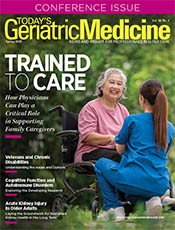
Spring 2025
Spring 2025 Issue The Last Word: Addressing the Loneliness Epidemic As individuals interested in caring for the needs of older adults, we understand the importance of addressing the physical health concerns of those we serve. Though far from ubiquitous, chronic diseases and physical limitations tend to accumulate with advancing age, and balancing the needs of these individuals can require substantial heavy lifting from providers and caregivers alike. In balancing these needs, physicians often fall victim to neglecting those needs that may be less obvious, but equally as damaging to health, longevity, and overall quality of life. In the past four years, the US Surgeon General, The National Academies of Sciences, Engineering, and Medicine, and the World Health Organization have all declared loneliness an epidemic and a public health priority. As you might have surmised, loneliness and social isolation peaked during COVID-19 in 2020, with over 50% of adults aged 18 and up reporting at least some feelings of loneliness and/or social isolation. While those rates have reduced somewhat since the height of the pandemic, prevalence remains higher compared with prepandemic levels, with about one in three adults reporting some loneliness and one in four reporting social isolation. Not only do experiences of loneliness and social isolation remain incredibly common, but it is costly (adding an estimated 6.7 billion dollars to Medicaid costs per year) and catastrophic to health. It is more than just a feeling—it is a biopsychosocial stressor with a mortality risk comparable with smoking more than 15 cigarettes a day and more deleterious than alcoholism, obesity, and physical inactivity combined. Older adults aren’t the only age group vulnerable to loneliness (see the myriad of data on youth and emerging adults), but shrinking social networks due to life events like retirement, spousal or familial death, shifting social goals, and health conditions that change or limit opportunities for social connection leave older adults, particularly at risk. Now that we understand that loneliness is an epidemic worthy of our time and effort, what can providers do to ease the burden? 1. Recognize the groups most vulnerable to loneliness and social isolation. We know that older adults are particularly vulnerable, but older adults who live alone, near or under the poverty line, suffer from chronic diseases and disabilities, or who are immigrants or members of the queer community are even more susceptible. 2. Screen for loneliness and social isolation. While all health care workers’ time is limited, it is important to screen for both, so brevity is king. Though often used interchangeably, loneliness (a subjective feeling of being socially isolated) and social isolation (an objective lack of social connection) are two different phenomena that can influence health through different mechanisms. Those complexities are beyond the scope of this piece but are important subjects of current research in the field. In general, those who are objectively isolated (ie, have little to no social interaction) and who are also subjectively lonely (ie, they express discomfort with their level of social interaction) will most benefit and be most accepting of intervention. 3. Maintain an easily accessible list of resources local to your area. A few good places to start can include community centers, religious institutes, and local hobby groups relevant to your patients’ interests. Finally, as the old adage goes, “An ounce of prevention is worth a pound of cure.” It is much easier to avoid becoming lonely or isolated than it is to change course. Encourage all of your patients, but especially those from socially vulnerable groups going through life transitions, to stay connected to friends and family and to build new, fulfilling relationships. — Monica M. Williams-Farrelly, PhD, is a research scientist at the IU Center for Aging Research at Regenstrief Institute and an assistant research professor at Indiana University School of Medicine. She is an early career scholar whose research interests focus broadly on the life course origins of health and health disparities. |
